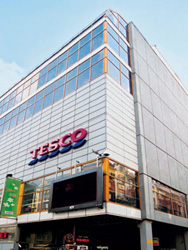
Department store Máj celebrates 40 years since its opening
 |
The prominent building at the corner of Spálená and Národní streets was built on the site of the neo-Gothic Šlik Palace according to designs by architects Miroslav Masák, John Eisler, and Martin Rajniš from the Liberec studio SIAL, established in 1968 by Karel Hubáček, the creator of the Ještěd television tower. It was implemented by two Swedish companies - SIAB and ABV Stockholm. The façades of Máj feature the contrast of the fully glazed escalator hall with the unarticulated concrete tower of freight elevators.
According to architectural historian Rostislav Švácha, the building responds promptly to the challenge posed to the world in 1972 by the project of the Paris museum Centre Georges Pompidou, designed by pioneers of the high-tech style, Renzo Piano and Richard Rogers. In this sense, Máj was noted in foreign architectural magazines - few Czech buildings of the 20th century received such publicity. In March 2006, Švácha submitted a proposal to declare Máj a cultural monument.
Among other reasons was the reaction to the fact that the owner of the building (Tesco Stores ČR since 1996) initially planned its demolition, followed by extensive reconstruction. The Ministry of Culture declared Máj a cultural monument in October 2006; it is considered a significant example of 1970s architecture, also in a European context, as it follows the interwar functionalism and foreshadows the high-tech style in the interior. The final verdict on the monument status was made in January 2007.
The dispute over the monument protection of Máj (built between 1972 and 1975) stirred public discussion about whether not only historical but also significant modern buildings, which people do not yet view as monuments, deserve protection, particularly if they originate from the previous regime. The ministry's decision thus became an important precedent. Máj has always evoked emotions; some critics object to its certain aggressiveness towards the surrounding buildings.
During its forty-year existence, the department store has changed its name five times. From the original Prior 02, it soon became Máj. In 1992, the center transitioned to the brand of the American chain K-Mart. Since 1996, it has been owned by Tesco. Originally, the department store operated under this brand, but in 2009 it was renamed to My. At the same time, it underwent extensive interior renovations.
The department store offers customers goods over six floors on an area greater than 12,000 m². It employs over 350 people.
The English translation is powered by AI tool. Switch to Czech to view the original text source.
0 comments
add comment
Related articles
0
16.07.2025 | The owners of Máj requested an extension for the placement of butterflies on the facade of the building
0
13.05.2025 | <Motýli na Máji mají povolení do srpna, majitel budovy požádá o prodloužení>
<Butterflies in May have permission until August, the building owner will apply for an extension>
0
07.03.2025 | The owner of Mája is considering requesting an extension of the consent for the placement of butterflies
0
09.12.2024 | The owner of Máje is preparing to sell it to a related fund for billions
0
30.09.2024 | The shopping center Máj has permanently closed the indoor playground Lvíčkov today
0
12.08.2024 | The illegal children's playground will be removed from the roof of the department store Máj
3
25.06.2024 | Experts and the public criticize the design of the reconstruction of the Máj department store in Prague
0
24.06.2024 | People could visit the renovated department store Máj for the first time today
1
16.05.2024 | The department store Máj in Prague will open to the public on Monday, June 24
0
12.03.2024 | The Club for Old Prague is against the placement of moving butterfly sculptures at the Shopping Center Máj
0
16.03.2023 | The reconstruction of the OD Máj in Prague will be completed next year, costing four billion CZK
0
16.05.2022 | The spaces of the department store Máj in Prague are closed; reconstruction will begin
5
20.04.2022 | In June, the reconstruction of the Máj department store will begin, lasting a year and a half
17
30.04.2020 | Against the approval of the reconstruction of the Prague department store Máj
1
29.04.2020 | Club For Old Prague Protests against the Intended Reconstruction of Máj
0
18.02.2019 | The Prague department store Máj bought Amádeus Real from Tesco
0
02.03.2018 | The department store Máj is a significant representative of 1970s architecture
0
02.03.2018 | Tesco sells the department store My in the center of Prague
0
01.10.2012 | KOTVY MÁJE - discussion of R. Švácha, M. Masák, and R. Žertová
0
14.09.2012 | Exhibition ANCHORS OF MAY in Brno
3
10.09.2009 | Tesco has completed the renovation of the Máj department store
0
03.01.2007 | The ministry has definitively decided that May will be a cultural monument
0
23.10.2006 | The ministry declared the Máj department store a cultural monument
0
21.03.2006 | Švácha submitted a proposal to declare Máj a monument











